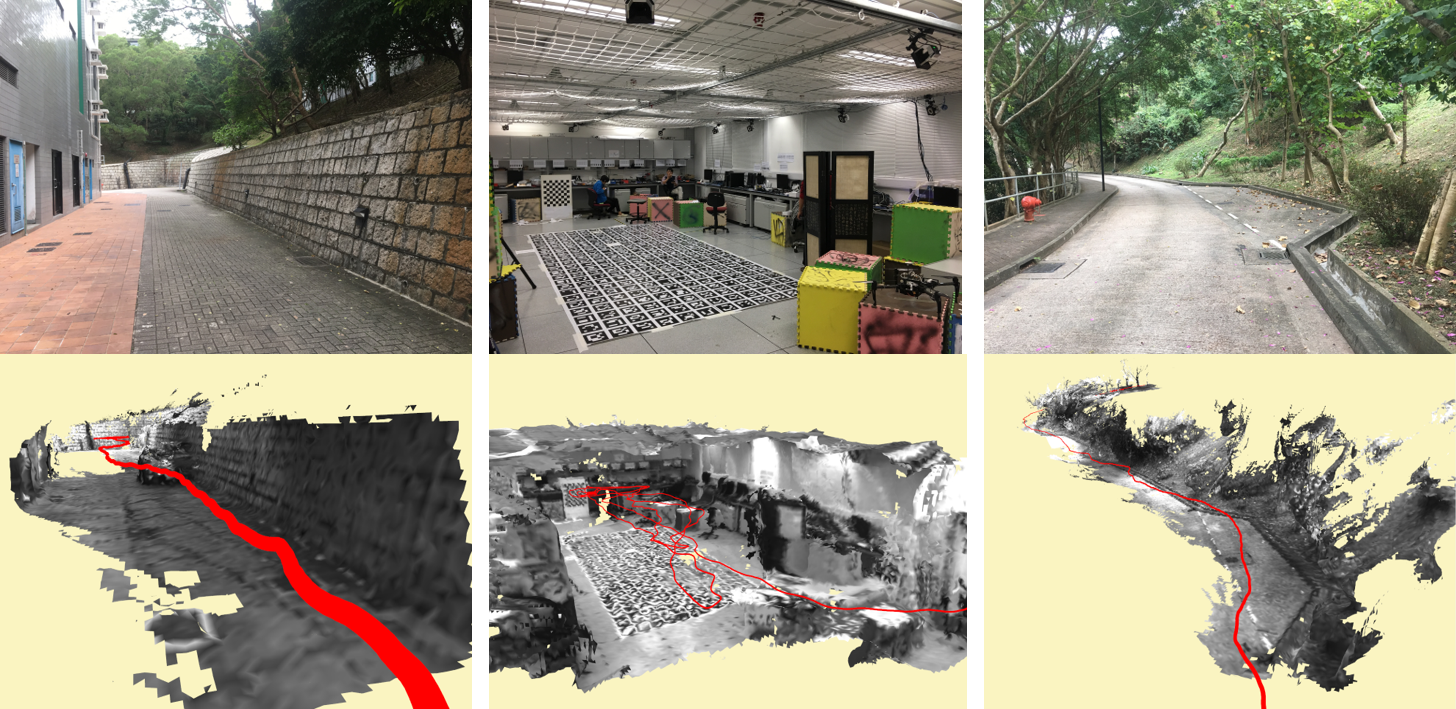HKUST-Aerial-Robotics / Open_quadtree_mapping
Projects that are alternatives of or similar to Open quadtree mapping
QuadtreeMapping
A Real-time Monocular Dense Mapping System
This is a monocular dense mapping system following the IROS 2018 paper Quadtree-accelerated Real-time Monocular Dense Mapping, Kaixuan Wang, Wenchao Ding, Shaojie Shen.
Given a localized monocular camera, the system can generate dense depth maps in real-time using portable devices. The generated depth maps can be used to reconstruct the environment or be used for UAV autonomous flight. An example of real-time reconstruction is

Red line is the camera trajectory.
A video can be used to illustrate the pipeline and the performance of our system:
We would like to thank rpg_open_remode for their open source work. The project inspires us, and the system architecture helps we build QuadtreeMapping.
Please note that, in the system, the depth value is defined as Euclidean distance instead of z value. For example, if the point is (x, y, z) in camera coordinate, the depth value is
This branch uses opencv totally on CPU. If you need to speed up the image undistort step by using OpenCV with CUDA, please checkout to master branch.
1.0 Prerequisites
- Ubuntu and ROS
Both Ubuntu 16.04 with ROS Kinect and Ubuntu 14.04 with ROS Indigo are ok.
- CUDA
The system uses GPU to parallel most of the computation. You don't need a powerful GPU to run the code, but it must be a Nvidia GPU that supports CUDA. We use CUDA 8.0 to run the system. CUDA 9.0 has not been tested yet.
- OpenCV
The OpenCV that comes with ROS is ok.
2.0 install
Since the GPU device varies from each one to another, the CMakeLists.txt needs to be changed accordingly.
cd ~/catkin_ws/src
git clone https://github.com/HKUST-Aerial-Robotics/open_quadtree_mapping.git
cd open_quadtree_mapping
now find the CMakeLists.txt
First, change the Compute capability in line 11 and line 12 according to your device. The default value is 61 and it works for Nvidia TITAN Xp etc. The compute capability of your device can be found at wikipedia.
After the change of CMakeLists.txt, you can compile the QuadtreeMapping.
cd ~/catkin_ws
catkin_make
3.0 parameters
Before running the system, please take a look at the parameters in the launch/example.launch.
-
cam_width, cam_height, cam_fx, cam_cx, cam_fy, cam_cy, cam_k1, cam_k2, cam_r1, cam_r2are the camera intrinsic parameters. We use pinhole model. -
downsample_factoris used to resize the image. The estimated depth maps have size ofcam_width*downsample_factor x cam_height*downsample_factor. This factor is useful if you want to run QuadtreeMapping on platforms with limited resources, for example Jetson TX1. -
semi2dense_ratiois the ratio to control output depth map frequency and must be an integer. If the input camera-pose pairs are 30Hz and you only need 10Hz depth estimation, setsemi2dense_ratioto 3. High-frequency camera-pose input works better than a low-frequency input even you want a low-frequency depth estimation.
4.0 run QuadtreeMapping
The input of QuadtreeMapping is synchronized Image (sensor_msgs::Image) and Pose (geometry_msgs::PoseStamped). Make sure the ROS messages are the correct type and the timestamps are the same. Images and poses at different frequencies is ok. For example, the system will filter 30Hz images and 10Hz poses into 10Hz image-pose pairs as input.
4.1 run the example
We provide an example of a hand-held camera navigating in a garden. We provide the link to download the bag. The ego-motion is estimated using VINS-MONO.
To run the example, just
roslaunch open_quadtree_mapping example.launch
and play the bag in another terminal
rosbag play example.bag
The results are published as:
- /open_quadtree_mapping/depth : estimated depth for each pixel, invalid depth are filled with zeros,
- /open_quadtree_mapping/color_depth : color-coded depth maps for visualization, invaild depth are red,
- /open_quadtree_mapping/debug : color-coded depth of pixels before depth interpolation.
- /open_quadtree_mapping/reference : undistorted intensity image,
- /open_quadtree_mapping/pointcloud : point cloud from the current undistorted intensity image and the extracted depth map.
4.2 run with other datasets or run live
To run with other data, you can modify the launch file according to your settings. To get good results, a few things need to be noticed:
- Good ego-motion estimation is required. The ego-motion should be precise and have the metric scale. We recommend using VINS-MONO to estimate the camera motion. Visual odometry systems like ORB-SLAM cannot be directly used unless the scale information is recovered.
- Rotation is not good for the system. Rotation reduces the number of frames QuadtreeMapping can use to estimate the depth map.
- A good camera is required. A good choice is an industry camera that has a global shutter and is set to a fixed exposure time. Also, images should have a balanced contrast, too bright or too dark is not good.
5.0 fuse into a global map
Quadtree publishes depth maps and the corresponding intensity images. You can fuse them using the tool you like. We use a modified open chisel for 3D reconstruction and use a GPU-based TSDF to support autonomous flight.
6.0 future update
- modified open chisel will be open source soon.

